Submissions – Education NSW Curriculum Review
1. Addressing the Decline in the Study of Economics
1.1 The interests of the Reserve Bank of Australia
The review of the New South Wales Curriculum presents an opportunity to increase awareness of the importance of Economics as a field of study. This matters for three key reasons. First, studying Economics helps raise the level of economic literacy in the wider community so that citizens are better informed about the economic decisions they make and the economic events that affect them. Second, with active engagement in the study of Economics, there is more likely to be a talented and diverse pool of economic graduates from which organisations can recruit, particularly those organisations that make public policy decisions. Third, the analytical skills acquired in the study of Economics are well suited to the changing nature of work and are rewarded by the labour market.
The Bank has observed a significant decline in the size and diversity of the student population in Economics – both at a secondary and tertiary level. It is concerned about the implications of this for economic literacy and the longer-term health of the economics profession. Consequently, the Bank has made submissions to some syllabus reviews, including the recent NESA Review of Commerce Years 7–10 Syllabus. The current NESA review of the New South Wales Curriculum as a whole provides an opportunity to elevate the study of Economics as a subject. It also creates opportunities for economic concepts and content to be embedded into other subjects so that awareness of the relevance of economics can encourage students to subsequently study it in Year 12 or at university.
1.2 Trends in Economics enrolments in New South Wales
Graph 1 shows Year 12 Economics enrolments in New South Wales from 1991 to 2017. In 1991 nearly 40 per cent of Year 12 students studied Economics and it was the third most popular subject choice, surpassed only by English and Mathematics. However, the introduction of new subjects in 1991 saw a sharp rise in enrolments in Business Studies (and other vocationally oriented subjects). The displacement of Economics was pronounced. Business Studies expanded steadily throughout the 2000s and, in recent years, there has been renewed interest in it, with Business Studies in 2017 being the fifth most popular subject choice. In contrast, student demand for Economics is relatively low, and a growing number of schools are considering the feasibility of offering the subject.

In a crowded curriculum, uncertainty about the nature of a subject and the rewards for studying it weigh on the subject choices made by students. Importantly, many students do not understand what economics is and how it might be relevant to them. As an analytical subject with a quantitative element, Economics is often perceived as being difficult to learn. It is also often described as difficult to teach – especially given the limited availability of teaching resources with an Australian context and the challenge of incorporating changing economic conditions into lesson plans. This is especially so for less experienced teachers and those teaching out of field. In contrast, Business Studies is widely perceived as a more employable subject than Economics, less demanding for students to learn and easier for educators to teach (with fewer concepts to explain and more readily available content). These factors are contributing to Economics being offered at fewer schools through time.
Looking at the types of schools that offer Year 12 Economics, Graph 2 shows that in the early 1990s Economics was taught at over 90 per cent of both government and non-government schools. By 2017, only around 30 per cent of government schools taught Economics, while around 55 per cent of non-government schools taught it.

The fall in Economics enrolments is a particular feature of the comprehensive public schools that most students attend (Graph 3). In contrast, having declined in the early 1990s, the level of Economics enrolments in the state's selective schools has remained fairly steady, consistent with Economics being an analytical subject (and one that is perceived to ‘scale well’ in an ATAR).

The changing patterns of enrolments by school type are associated with changes in the socio-economic profile of the Economics student population. Looking at each secondary school in New South Wales according to its socio-economic status (SES), the fall in enrolments has been most pronounced for schools with a low SES rank.
Graph 4 takes the (declining) total population of Economics students and presents the share of that population in each of the three broad categories of low, medium and high SES. It shows that the decline in the share of students from low SES schools has been offset by a rise in the share of students from high SES schools. This says something about the challenges for less well-resourced schools in offering Economics.
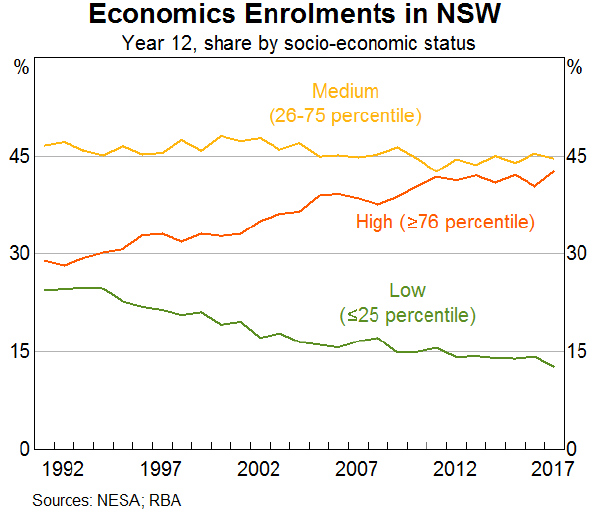
Turning to gender, there is a declining share of female students who are enrolled in Year 12 Economics. Whereas in the early 1990s, the proportion of male and female students was approximately equal (with the share of female students only marginally less than that for males), by 2017 there were almost two male students for every female student (Graph 5).
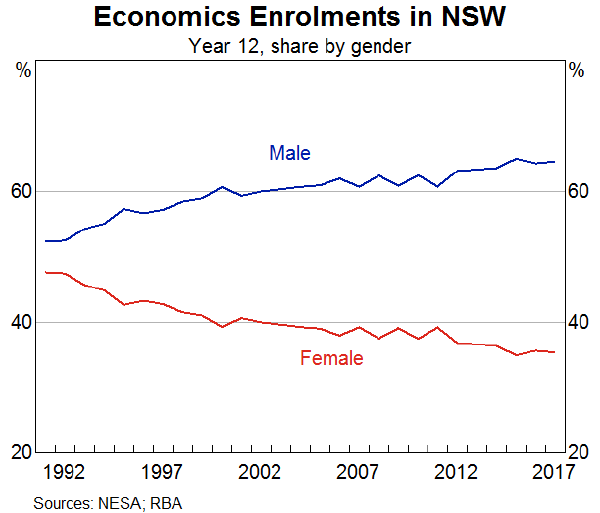
1.3 Comparisons with STEM
It is instructive to compare the decline in the size and diversity of the Economics student population with that of STEM subjects (Science, Technology, Engineering and Mathematics). As shown in Graph 6, the fall in Year 12 Economics enrolments since 1991 has been much more pronounced than for Year 12 STEM subjects.
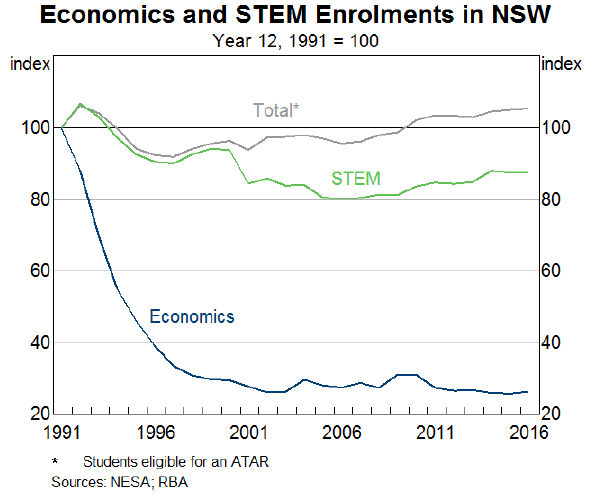
Furthermore, among Year 12 students, female participation in Economics has fallen by more than that in STEM subjects, while female participation in Business Studies has remained relatively high and stable (Graph 7).
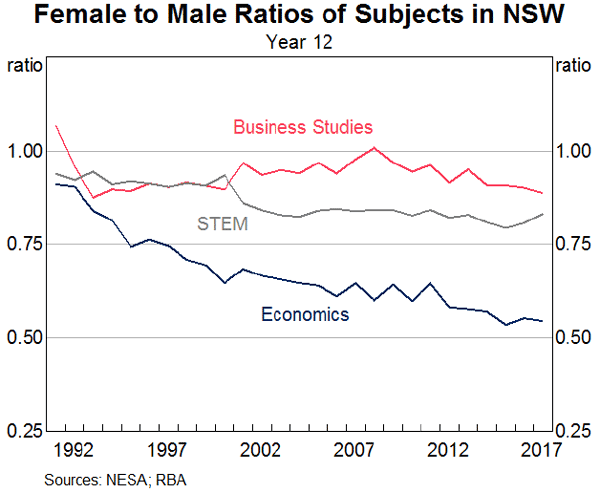
The fall in STEM participation, particularly by female students, was considered to warrant a policy response. There are currently numerous initiatives and a large commitment of resources from both public and private sectors to address the issue. This is because competency in STEM is a prerequisite to many fields of study and productive activities. Economics at school is not a prerequisite for any field of study (including Economics at university). However, there are benefits to studying economics that are both societal and private.
2. The Benefits of Supporting the Study of Economics
2.1 The social benefits
Economics is about how individuals and societies choose to allocate their limited resources to meet their needs and wants. It is about how they respond to incentives, make trade-offs, weigh up costs and benefits – and how they decide what is efficient and what is fair. Economics contains powerful concepts and useful frameworks. As such, it can help students better understand the choices involved in the personal decisions they make, and better understand the economic conditions and policies that do, or will, affect their lives. Consequently, studying Economics can enhance economic literacy of students and the wider community.
Supporting the study of Economics so that it is available to a wider range of students has other social benefits. It will help increase the diversity of the Economics student body – both at school and university. In the long run, increased diversity can be expected to raise the collective ability of the economics profession. And because those who study Economics shape the discipline and determine economic policies, it is desirable that the population of economics graduates is broadly representative of society.
2.2 The private benefits
In addition to the social benefits that arise from supporting the study of Economics, there are private benefits. This is because the labour market values the skills learned in the study of Economics. In a recent Bank study entitled Does It Pay to Study Economics?, Bishop and Guttmann (2018) sought to quantify the returns to these skills. Of particular relevance is their finding that of the 82 fields of study they examined, Economics was the 7th most diverse in terms of the range of the occupations in which qualification holders have employment, and the 17th most diverse in terms of the industry in which they are employed. In fact, someone who has post-school qualifications in Economics can work in a wide array of industries – regardless of whether they are actually employed as an economist. While those who are employed as economists are more likely to work in policy roles in the public sector, professional services or finance, those who have studied Economics are just as likely to work in public policy as they are in household services (Graph 8). This reflects the broad applicability of the skills acquired in the study of Economics to various forms of employment.
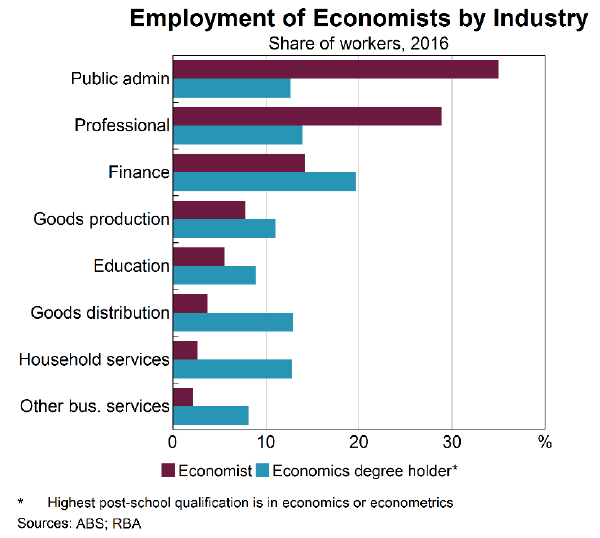
Furthermore, the earnings of those who have studied Economics are likely to be higher than for most other fields of study. As shown in Graph 9, average earnings of Economics graduates is surpassed only by those whose main subject area was IT or Engineering (Bishop and Guttmann 2018).
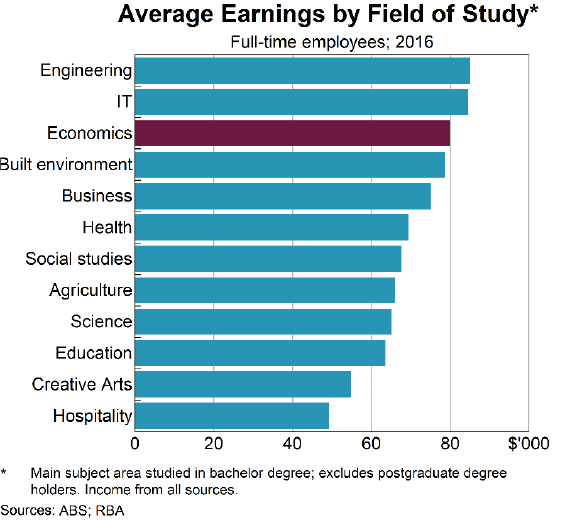
Importantly, the sorts of skills acquired in the study of economics – in particular, analytical and problem solving skills – are likely to be highly valued as the nature of work changes (as explained by the Bank's Head of Economic Analysis, Alex Heath, in her speech on Skills for the Modern Workforceds). It is perhaps because Economics graduates are less likely to be directly employed in their subject field that the misperception about employability arises. This is, however, analogous to the experience of the Mathematics student who is less likely to become a mathematician than to employ mathematical skills in various occupations.
3. Opportunities Arising from the Curriculum Review
3.1 Renewed focus on Economics
The Review of the New South Wales Curriculum provides a timely opportunity to help arrest the decline in the study of Economics and shift Economics closer to the core subjects. In an era where there are growing challenges to equipping students for the future, it is relevant that the skills acquired in the study of Economics (analytical, problem solving and quantitative skills) are likely to remain in demand as technological advances change the nature of work.
Students have a vital interest in what makes good public policy. As young people, they want to know what the future holds for them. They consistently ask Bank presenters about issues of long-term economic growth, intergenerational equity, job opportunity, income distribution, housing affordability, how economies can avoid another financial crisis, and what incentives can be used to protect the environment. Students also have great interest in understanding their own material welfare. In brief, they are interested in the personal and collective choices that determine welfare, now and in the future. This all relates to economics. Consequently, Economics can be an engaging subject area in the curriculum that helps equip students as citizens and prepares them for a world of unpredictable economic, social and technological change.
3.2 Embedding Economics into other subjects
The New South Wales Curriculum Review also provides an opportunity to embed Economics into a range of subjects. Economics can assist with the understanding of another discipline (e.g. Economics can provide insights into aspects of Commerce, Modern History and Environmental Studies). Economics can also be interpreted from the viewpoint of another discipline (e.g. economic relationships can be a worked example of Mathematics). Of the opportunities to incorporate Economics topics or modules into another field of study, Commerce is one of the most complementary fields. Commerce also has a large student base (with around one-quarter of Year 7-10 students studying it) and a reasonable gender balance, increasing the potential for a sizeable population of students to be exposed to economic concepts and issues. (The Bank made a submission to the recent NESA Review of Commerce Years 7– 10 Syllabus in support of Economics becoming a core component of the syllabus.)
Currently, at the conclusion of Year 10, students discontinue Commerce but may choose one of the curriculum specialisations they were exposed to in the Commerce syllabus to pursue in Years 11-12. These specialisations include Legal Studies, Business Studies and Economics. The present focus of the core units in Commerce provides clearer exposure and a more direct continuum of learning to Business Studies and Legal Studies than to Economics. If a revised syllabus for Commerce provides greater exposure to economic concepts and issues – especially those that are relatable – the likelihood of students subsequently choosing to study Economics will increase. Increased student engagement, combined with the requirement to deliver Economics as part of the core Commerce content, may also encourage greater teacher engagement with Economics and ultimately give teachers more confidence in the delivery of Economics material.
3.3 National curriculum
While revision of the Years 7-10 Commerce syllabus provides a near-term opportunity to strengthen the currency and relevance of its economic content, the implementation of the Australian Curriculum in Economics and Business Education would provide a much more significant opportunity for a continuum of learning in Economics for all school students in New South Wales, including from primary school.
4. The Reserve Bank's Support for Economics
In response to the sharply falling size and diversity of the Economics student population, along with the challenges experienced by many educators delivering Economics courses, the Reserve Bank established a public education program, coordinated by a new Public Access & Education team.
The program provides a range of content about economic concepts, economic conditions and the activities of the Reserve Bank that are aligned to the current curriculum. While these resources have been principally designed to support senior secondary students and educators, many are relevant for more general audiences and a range of materials for younger audiences is being developed. In addition to development of relevant content, the public education program includes an Ambassador program in which Bank economists give presentation to students and teachers – at Bank facilities, established educational fora and at schools. Furthermore, the Bank has introduced professional development activities for educators. A summary of the program can be found in the Appendix.
However, in addition to offering these direct practical measures of support, the Bank sees benefit in ensuring that syllabi (at both secondary schools and universities) support the longer-term health of the Economics student body. The review of the curriculum in New South Wales provides scope for increasing students’ access to, and engagement with, Economics.
5. Recommendation
Over the course of a generation, there has been a marked decline in the study of Economics. As Economics is a subject that generates significant social and private benefits, the Reserve Bank of Australia recommends that Economics is found a more prominent place in a refreshed curriculum.
Recommendation:
- Ensure that all students, throughout their secondary school years, are exposed to relevant and relatable economic concepts and issues.
- Equip more students to choose Economics as a subject in Year 12.
- Equip more teachers to deliver Economics, including those who are currently teaching out of field.
- Equip more teachers to embed Economics into other subjects, including at different stages of learning.
Appendix: The Reserve Bank’s Public Education Program
The Reserve Bank has recognised the importance of supporting Economics educators and students, as well as the general public. The Public Access & Education team coordinates a program that includes the elements listed below.
Educators Advisory
Panel The Reserve Bank has established a group of external education experts to provide feedback and guidance on the Bank's initiatives in support of Economics education. The Panel comprises presidents of the national and state associations for Economics educators, the president of the national careers advisory body, two academics and two ‘best practice’ teachers.
Professional Development
Professional development activities for Economics educators have been provided. The annual Teacher Immersion Event is accredited as Registered Professional Development (addressing 6.2.2, 6.3.2 and 7.4.2 from the Australian Professional Standards for Teachers) towards maintaining Proficient Teacher Accreditation in New South Wales.
Ambassador Program
An Ambassador Program has been established, with a group of Reserve Bank economists being equipped to deliver talks to teachers and students and act as advocates for economics who exemplify what an economist does.
Educational Talks
The Reserve Bank Ambassadors give talks to students and educators on economic concepts, economic conditions and the roles and functions of the Reserve Bank. These talks are delivered at the Bank, large forums and conferences, lectures at universities and include visits to schools.
Resources
Curriculum-relevant content is being developed to meet the needs of Economics educators and students. It is available on the Education section of the Bank's website. Current content includes:
- Explainers, In a Nutshells, Snapshots – various short guides that contain information with different levels of detail. They cover key economic concepts, economic developments, economic statistics and responsibilities of the Reserve Bank.
- Chart pack – graphs summarising macroeconomic and financial market trends in Australia (updated monthly).
- Standard presentations – slide presentations on the Bank's roles and functions, monetary policy formation and recent economic trends in Australia.
- Videos – videos that explain what economics is and its relevance. In one video entitled What is Economics?, Bank economists explain what economics is, the skills that economists use and the issues to which they are applied. In another entitled The Future of Work, a senior Bank economist talks about the changing nature of the Australian workforce and the skills that will be highly valued in the future.
Scholarship
The Reserve Bank sponsors a Premiers' Teaching Scholarship devoted to developing a more inclusive approach to teaching Economics to women and girls.
References
Bishop, J and R Guttmann (2018), ‘Does it Pay to Study Economics’ RBA Bulletin, September.
Dwyer, J (2018), ‘What Happened to the Study of Economics?’, Address to the Business Educators Australasia Annual Meeting, Sydney, 26 May.
Dwyer, J (2017), ‘Studying Economics: The Decline in Enrolments and Why it Matters’, Address to the Business Educators Australasia Annual Meeting, Sydney, 29 July.
Heath, A (2017), ‘Skills for the Modern Workforce’, Remarks to the Victorian Career Advisors Conference, Melbourne, 1 December.
RBA (2018), Submission to NESA Review of Commerce Years 7–10 Syllabus, December.
Endnotes
This submission draws on the research of economists in the Reserve Bank's Public Access & Education Team, Tim Atkin and Tanya Livermore, and those on secondment to the team, Richard Evans and Melissa Wilson. Aspects of this work can be found in speeches delivered by Jacqui Dwyer in 2017, ‘Studying Economics: The Decline in Enrolments and Why it Matters’ and in 2018 ‘What Happened to the Study of Economics?’. [*]